Update September 13: Since I first posted this on September 6, I finished fine-tuning my food list and packing my pack. The event requires a minimum calorie count of 14,000 and minimum food weight of 7.7 lbs.; my food comes to just over 14,000 calories and weighs 8 lbs. You can see the list of my food here. I managed to fit everything into my pack and it weighs exactly 17 pounds with the water bottles filled. I’m pretty happy about that. See below for some updated info & photos.
Update October 3: I’m adding a few notes to this post about last-minute additions to my kit. Also I wrote a blog post here about how the week unfolded for me.
The Grand to Grand Ultra is one week away! done! It’s been 2+ years since I prepped for a self-supported stage race, 2017’s Mauna to Mauna. As in past years, I’ll make notes about training and a list of my gear & food to help others who may be training for a self-supported stage race, or who just want to find out about ultra-lightweight gear for fastpacking and camping.
The race runs from Sunday, Sept. 22, through Saturday, Sept. 28, covering 170 miles broken into the following mileage: 31, 27, 52, 26, 26, and the final day’s “sprint” of 8 miles. It’s extremely difficult due to the combination of running/hiking a marathon or more day after day with a pack, on sandy tracks and sometimes off-trail through prickly vegetation, and coping with extreme heat, afternoon rain storms, and freezing temperatures in the final night’s camp. Stage 3’s 52-miler feels as challenging as a 100-miler, because we start with 58 miles of fatigue on our legs from the first two stages, and we have to climb the route’s most challenging bluffs and sand dunes with the weight of a pack.
Seriously, I can’t wait to do it again!
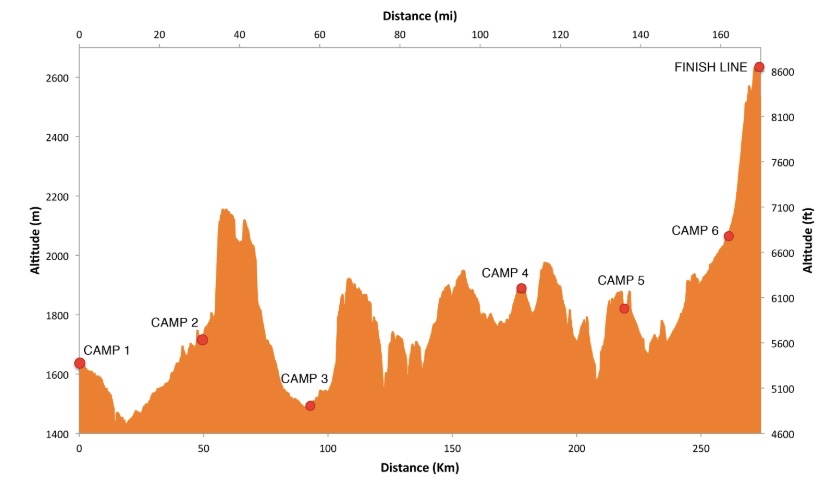
The Grand to Grand Ultra’s route profile.
How to follow the race & support me
You can find out more about the event, and get updates during race week, by liking and following the event’s Facebook page. This is the best place to view photos and get news as the race unfolds. You can also follow their Instagram and twitter, and check the website https://g2gultra.com/g2g-homepage under “Race Coverage.” But results are notoriously delayed with uploading, due to the remote nature of the event where cell coverage is spotty at best, and the fact the race directors prioritize being at camp to manage the event rather than posting updates, so be patient.
I will be totally off the grid, leaving my phone behind, and not emailing any updates from the event because the event is ending the past years’ practice of having some laptops available at camp on which to send outgoing email. I support this move, as it enhances the event’s “digital detox” and forces everyone to be offline for the week. However, the event still accepts inbound emails, which volunteers print out and hand to competitors each afternoon at camp. I love getting these email letters from family and friends, so feel free to send one; a link to “email a competitor” will be published on the g2gultra.com website and available from Thursday, Sept. 19, until 6pm MDT on Thursday, Sept. 26. Note my bib # in the subject line: 121.
As a reminder, I would sincerely appreciate support for the nonprofit I’m running for, the Conservation Lands Foundation! You can read all about the cause, and how it relates to the Grand to Grand Ultra, here on my crowdrise page. I’m proud and gratified to have raised over $5000 so far, but I hope to hit the $10K mark by the time I cross the finish line! The landscape we’re running through is threatened, and we can’t take it for granted; it needs our support for conservation.
Training Recap
My training since moving to Colorado in May has been a good news/bad news story. I started the summer in strong shape from a spring marathon and a 57-mile ultra. But then my 100-mile race plan for June got thrown, so to speak, when I got bucked off a horse and fractured a vertebra. My training tanked for a while, but I rebounded in July and August, successfully running a mountainous 50K and then a 55K, both near Silverton.
Reflecting on my peak training, I wince at my relatively low weekly milage (due in large part to the slower pace around these mountains), ranging in the mid-50s to mid-60s most weeks during the past two months. I also have not trained with a fully loaded pack (18 – 20 lbs.) the way I did for past stage races; rather, I’ve kept my pack weight in the 12 – 15 pound range for most pack runs, not wanting to trash my lower body with the extra impact from the weight. I also have done zero sand-running practice, figuring I’ll rely on my knowledge and experience from past Grand to Grand Ultras to deal with the sandy sections. Heat training? Some, in the hot nearby town of Montrose, but not a lot.
On the bright side, here’s what I have going for me: I’ve been living at 9000 feet elevation, and training in mountains from 9K – 13K feet, for the past four months, so my cardiovascular system is adapted to thin air, and thus the altitude of the Grand to Grand Ultra, where the route ranges from 5000 to 8600 feet, should not pose a problem for me. Also, I’ve accumulated a lot of time on feet, hiking as well as running; last week, for example, my miles totaled only 63, but time on feet (running and hiking combined) totaled close to 20 hours due to some slow hiking with others, and elevation gain totaled 12,300! The total elevation gain for the Grand to Grand’s 170 miles is about 18,400 feet, and given how I’ve mixed in training on vert with runnable flat terrain, I’m not intimidated by the Grand to Grand’s elevation profile.

Hiking with my husband and dog last week on the Hardrock course; here we were at about 13K’ elevation, and we summited the 14.1K’ Handies Peak in the background. I hiked with about 15 pounds in my pack. I consider this slow-and-steady time on feet hiking as important as running for stage race prep. Also, this is the FastpackHer 30 pack I decided not to use for the Grand to Grand.
I also feel stronger, since I go to a strength conditioning “boot camp” type of class two mornings a week, and I do some additional conditioning and drills on my own. I am definitely slower than I was in my early 40s, when I first ran the Grand to Grand, but I’m counting on experience and grittiness to compensate for a slower pace.
I finished the past two Grand to Grand Ultras with the following cumulative times: In 2012, 43:05, 3rd F, 7th overall, 1st age group. In 2014, 39:26 (but the course was shortened by about six miles in final stage due to severe weather), 2nd F, 13th overall, 1st age group. Given how I’ve been running this year, I think breaking 45 hours is a good goal and 43 hours is a stretch goal.
What I’m Bringing
This is the fun part of stage racing: figuring out how to fulfill the required gear list, perhaps add a few “luxury” items, and be as light as possible! In past years, my pack at the start of Stage 1, with all my food for the week and full hydration bottles, weighed just a tad under 21 pounds. I am determined to get it under 20 pounds this year. I don’t know the final weight yet, because I’m still fine-tuning my food plan, but I will update this and share the total pack weight next week when I get all my sh*t together.
Mandetory Gear:
- Backpack: I struggled with which pack to use. Being an Ultimate Direction ambassador, I first tried UD’s FastpackHer30. Well, here’s proof that I’m not beholden to a sponsor. I wanted to like this pack, but for myriad reasons that I’ve communicated to Ultimate Direction, it didn’t fit me well and I didn’t like its features. Instead, I’m going with the Raidlight Women’s Responsiv 24L pack. It hugs me well, and I like its pocket design.
But I’m worried that I won’t fit everything in it, at least for the first couple of days until I eat through some of the food supply, so I’m supplementing it with my Ultimate Direction Race Belt 4.0. In this front-pack I’ll carry essential items I need easy access to: the checkpoint punch card, drink mix, gels, lip balm & sunscreen.Update: I don’t need this front pack after all; everything fits in my pack!
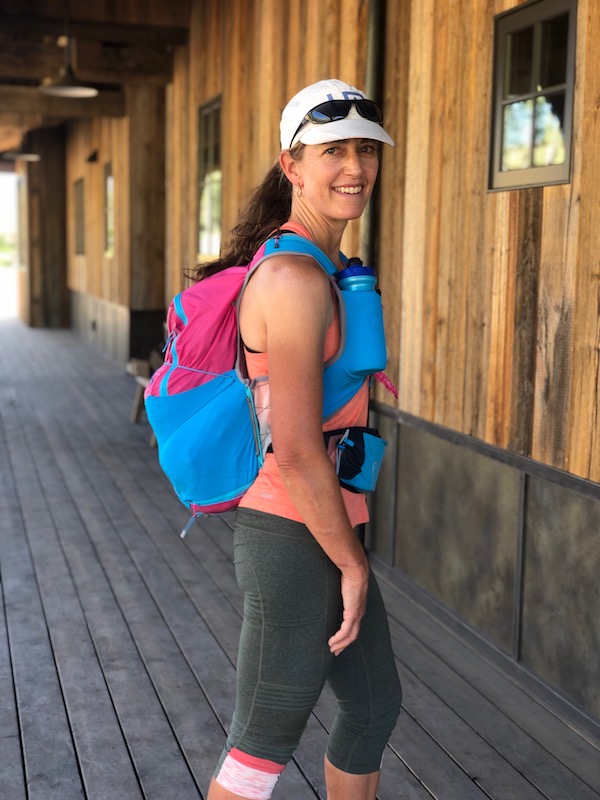
The Raidlight pack (only partially full in this pic) plus UD Race Belt combo.
Here is how the pack looks fully packed:
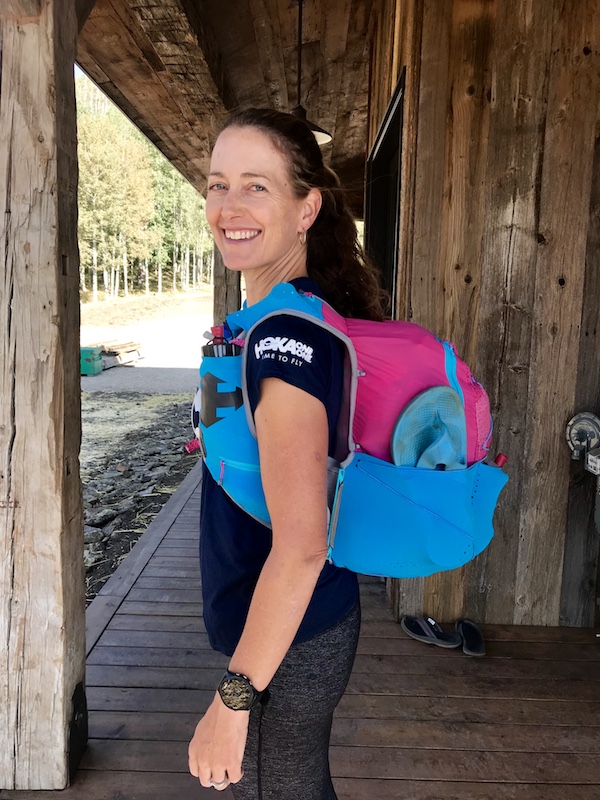
Post-race update: My bag failed during Stage 1! Read about what happened & how I had to fix it in my race report.
- Sleeping bag, temp rating 32F or lower: I upgraded my sleeping bag for this year. In the past three stage races, I’ve used the Montbell Down Hugger 3 weighing 1lb, 6oz. But now I’ve got the super small-but-warm-enough Yeti Fever Zero weighing less than 9oz! Check out the pic below, with old pack on left, new pack on right, about the size of a banana! Update post-race: It was barely warm enough, even wearing my wool base layers, down puffy, socks and a wool cap while sleeping.
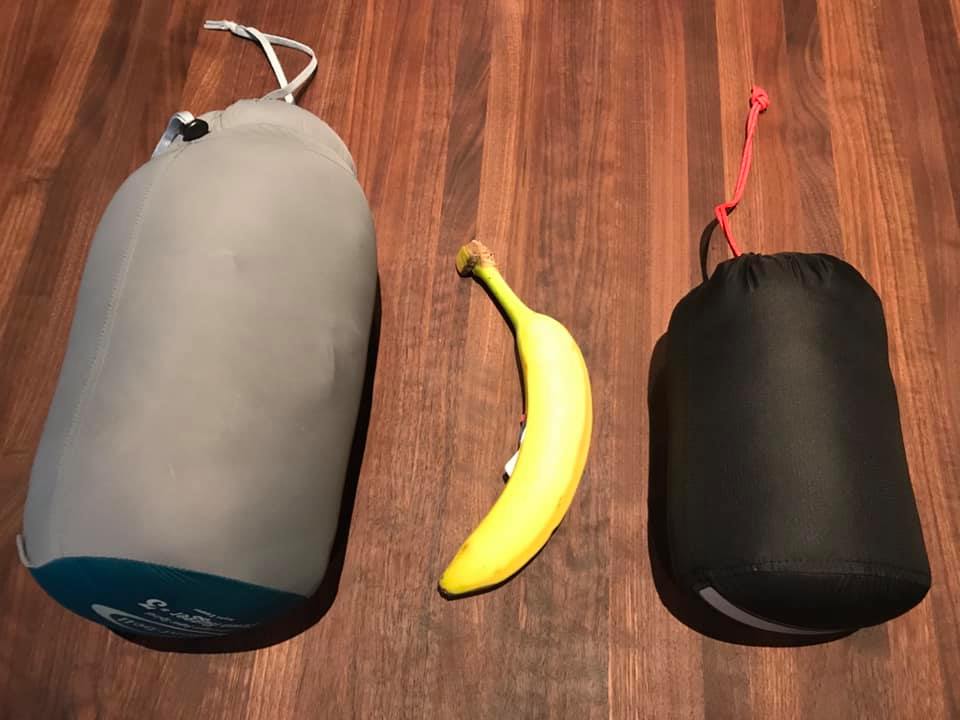
Old bag vs. new smaller sleeping bag on right.
- Sleeping pad: As in past stage races, I’ll use the Klymit Inertia X Frame, an inflatable “web” that deflates to about the size of a burrito. Update post race: This thing popped and deflated on the penultimate night of the race! I couldn’t find a hole, so I’m guessing a seam failed.
- Light down or fiberfill jacket: I’m sticking with the puffy I used in past stage races, a Sierra Designs Women’s Gnar Lite. Packs into a tiny stuff sack.
- Rain poncho or waterproof jacket with hood and taped seams: I’m using a cheapo plastic poncho bought at the local hardware store, as light and small as a folded-up baggie but effective. I’m actually taking two of them, because I think we face a high likelihood of afternoon rain storms, and these plastic ponchos can get trashed after a single use.
- Compass: Check, got it.
- Knife with 3-5 cm (1.1-2.0 in) blade: Check, got it.
- Signal mirror 20 cm2 (3 in2) minimum: Check, got it.
- Whistle: Built into my Raidlight pack.
- Foil emergency/space blanket:
Check, got it.Update: I decided to carry an emergency bivvy instead, which is basically two space blankets sewn together. That way, if my sleeping bag is not warm enough, I can tuck myself into the bivvy for extra insulation. - Two headlamps with spare batteries, each headlamp must be a minimum of 200 lumens: I’m using a combo of my Black Diamond Storm headlamp,
and my favorite lightweight flashlight, the Fenix PD32. I like having a hand-held light source in combo with a headlamp for the extra-challenging nighttime technical sections.Update: I decided to bring a second headlamp, the Black Diamond Spot, because it takes the same kind of batteries and thus I need only one set of spare batteries. - Red flashing light (to be affixed to backpack for night stage): Check, got it.
- Ability to carry 1.5 liters (50 oz) of water minimum: My Raidlight pack came with two ridiculous hot-pink soft flasks with straws, and I don’t like straws poking up in my face. Therefore I’m bringing two 17oz Ultimate Direction Body Bottles, along with a 16oz hard-plastic GU water bottle. I like having a hard-plastic bottle to set down at camp, and in which to shake and prep a post-run recovery drink. I will likely only use one of the Body Bottles, but I’m bringing an extra one in case the first one gets a hole, and/or if the temperatures are extreme and I need extra water between checkpoints.
- G2G race patches to be worn on one sleeve: Check, race organizers provide this.
- Country flag patch (rectangular, size approx. 2″ H x 3.5″ W) for your left shirt sleeve: Check, got this.
- Blister Kit sufficient for your needs for the entire event- (alcohol wipes, hypodermic needle(s), paper tape, elastic tape e.g. Rocktape): I’ve got all this neatly packed into a small baggie. Alcohol wipes are a godsend, so I’ll bring extra. I’m also adding a very small pair of scissors to cut tape. I’ll use my Rocktape as duct tape to repair any tears in my gear too. (In 2012, I fell into a spiky pinon tree that punctured my water bottle, but tape saved the day and patched the hole!)
I want to give a shout-out to fellow G2G competitor and veteran (he’s both a G2G veteran AND Army veteran) Vincent Antunez, who makes an anti-chafe product called Trail Toes, which is a sponsor of the event. His company generously gives all competitors Trail Toes to use, and I love this stuff for blister prevention and any hot spot on the skin. It’s good for toes and all over!
Non-mandetory “luxury items” I’m bringing:
- Toiletries: tiny toothbrush (no toothpaste, just a brush!) Update post-race: I caved & brought a tiny tube of toothpaste, and was glad I did, small tube of sunscreen, tiny tube of Aquaphor, tiny container of Squirrel’s Nut Butter anti-chafe Update: I threw this away because I didn’t need it; the Trail Toes worked great for anti-chafe; eye drops, a few meds (antibiotics in case of infection, like in 2012 when I got a badly infected toe on Day 2; anti-diarrhea, anti-nausea, a few Aleve anti-inflammatories),
Icy Hot patch in case my lower back starts causing a lot of pain(this proved to be too difficult to pack), a few strips of Coverall medical tape to put on my back and shoulders where pack may rub, ear plugs in case I share a tent with someone who snores, Diva Cup (because as luck would have it, I’m scheduled to have my period most of race week, ugh Update: yep, I needed to use this most of the week), small comb and extra hair bands (because I gotta braid my hair or it’ll drive me crazy). - Dry bag in which to pack extra clothing, sleeping bag, down puffy
- Spork & tiny plastic collapsible folding bowl: I debated whether I need a bowl, but I decided to have oatmeal on some mornings for breakfast, so I’m bringing this; bowl will double as mug for coffee.
- Extra safety pins (these are useful for hanging up clothes I ran in on side of tent after each stage, to let stinky damp shorts, bra, shirt & socks air out).
- Tiny talisman, a good luck charm I brought on past three stage races. It’s a one-inch-square carved stone buffalo, which my brother and sister-in-law gave to me before the G2G in 2012 with the note, “The Zuni were an ancient people who lived in the area through which you’ll be running on the G2G. They had talismans that represented different values. This buffalo was meant to symbolize endurance to overcome, and was a provider of great emotional courage to those who possessed it.”
Clothing
To be worn while I’m running:
- Ultimate Direction hat
- sunglasses
- Buff around neck, for sun protection and to wipe away sweat & snot (Buff doubles as washcloth at camp, and as a head wrap for cold nights)
- Smartwool short-sleeve shirt and Smartwool bra; I’ve become a fan of their lightweight Merino wool clothing, which dries out and doesn’t get as smelly as other fabrics.
- rabbit brand Dirt Pounders 2.0 shorts
- Drymax socks
- Hoka speedgoats (with Velcro sewn around them to hold down desert gaiters)
- Gaiters: I am bringing both sand gaiters by MyRaceKit, and regular gaiters by Altra. I like wearing regular, smaller gaiters on the stages with harder-packed dirt, because they trap less heat, and look and feel better, compared to full-cover desert gaiters. Update post-race: these full-cover sand gaiters worked great.
- Timex Ironman basic watch
To be worn at camp (these could also be considered “luxury items”):
- Oofos flip-flops (essential for having something to walk around in while my feet & blisters air out at camp); these are tough to pack, but they’ll stick out of an outer mesh pocket of my pack.
- small compression shorts, which will double as underwear, to wear at camp while my running shorts air out; if my regular shorts bug me or chafe excessively, then I can run in these.
- Northface lightweight long-sleeve wool base layer, for warmth at night
- thin lightweight cami top to wear around camp when it’s hot out, so I can take my sweaty bra off and let it air out and still be covered up
- Icebreaker long underwear; I’m bringing the long-sleeve top & long underwear because I know camp will get cold at night, and my sleeping bag is minimal.
- one extra pair of Drymax socks
- Update post-race: In the town of Kanab, I bought a Smartwool beanie and added it at the last minute. I was so glad I did; I needed the head warmth for the cold nights. Also, I wore an old pair of yoga pants to the first day’s camp for PJs, intending to throw them away. But I couldn’t bring myself to throw them away. They proved so useful, having another warm layer for my legs on cold nights, and fabric to fold as a pillow while lying in my tent. The yoga pants definitely were non-essential, but they made me happy.
What I’m NOT Bringing
- trekking poles: I realize I really don’t need these, and they’d be more trouble than they’re worth to carry all week.
- my phone for photos or music, and my Garmin: I’m unplugging for the week! My only device will be my Timex watch, which only has a basic stopwatch and time of day, not GPS. I don’t need these devices, and I wouldn’t want to carry a solar charger for them either. Also, the event strictly prohibits sharing the GPS tracking of the route.
- sun sleeves: I thought these would be good for sun protection, but I concluded that they bug me and feel too hot.
- gloves: If my hands get cold, I’ll keep them in my down jacket’s pockets.
Food
UPDATE: I finished choosing and packing my food. Here’s the list.
For this stage race, I’ve decided to rely more on liquid calories, i.e. drink mix. I’ve decided I don’t like “real food” while running, especially in the heat and thin air; it’s too hard to chew and swallow. GU Stroopwafels are the exception. Therefore I’m taking in hardly any solid food while running, just simple sugars and salts.
Below is a sample day for one of the regular marathon-to-50K-length stages. For the 52-mile long stage, I’ll add more drink mix plus have some potato chips and a Clif bar to get me through that day’s longer, tougher miles. Some mornings I’ll have a ProBar instead of oatmeal and peanut butter; for a couple of stages, I’ve added ProBar chews as well.
A typical day’s food, totaling 2000 – 2200 calories (depending on the calories in the dehydrated meal), features: oatmeal, nut butter, coffee for breakfast; 2 x GU Rocktane drink mix, 1 GU gel, one GU Stroopwafel to have while running; GU Recovery mix for post-run snack; one dehydrated meal. Tip: To make these more compact to pack, I poke a tiny hole in the packaging, squeeze out the air, tape up the hole, cut off extra packaging, and cram the day’s allotment into a Ziplock bag. I squeeze out all the air and tape up the Ziplock to make it as compact as possible.
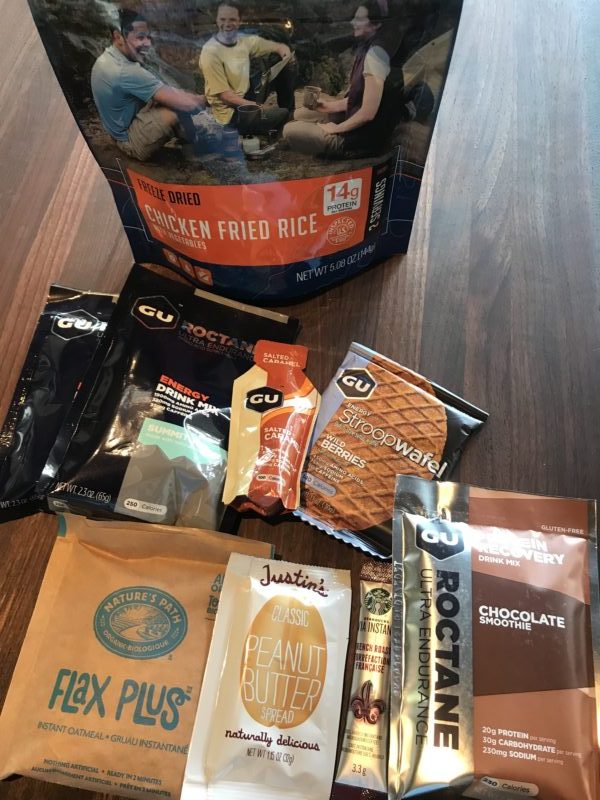
A typical stage’s food allotment.
Update post-race: Read my race report to see how this food strategy played out! Also as I explain in that report, I added a couple of additional snacks last minute—one Clif nut-filled bar, one more ProBar chews—and I took some food from town to camp to supplement the first morning’s breakfast.
Everything fits!
I’m happy everything fits, and with the water bottles filled and all the gear and food packed, my pack on Day 1 will weigh 17 pounds. It’ll lighten up as the week goes on and I eat through the food supply.
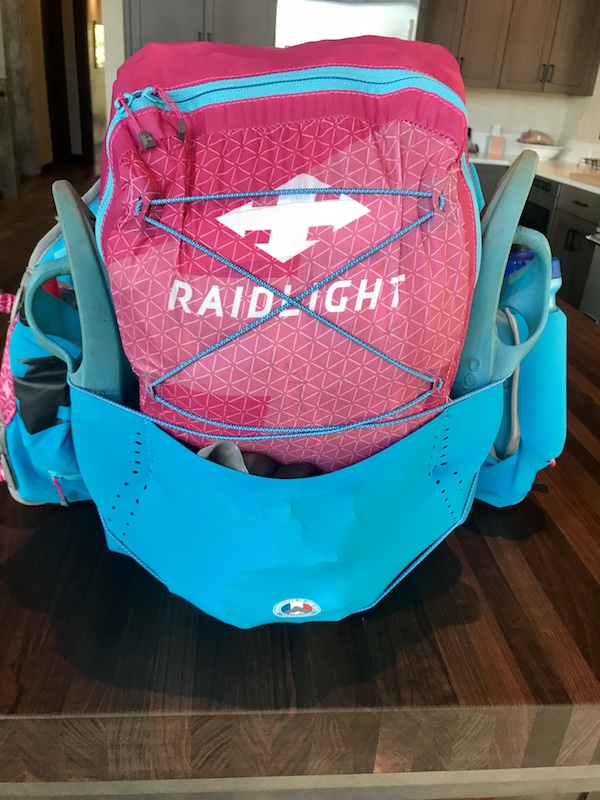
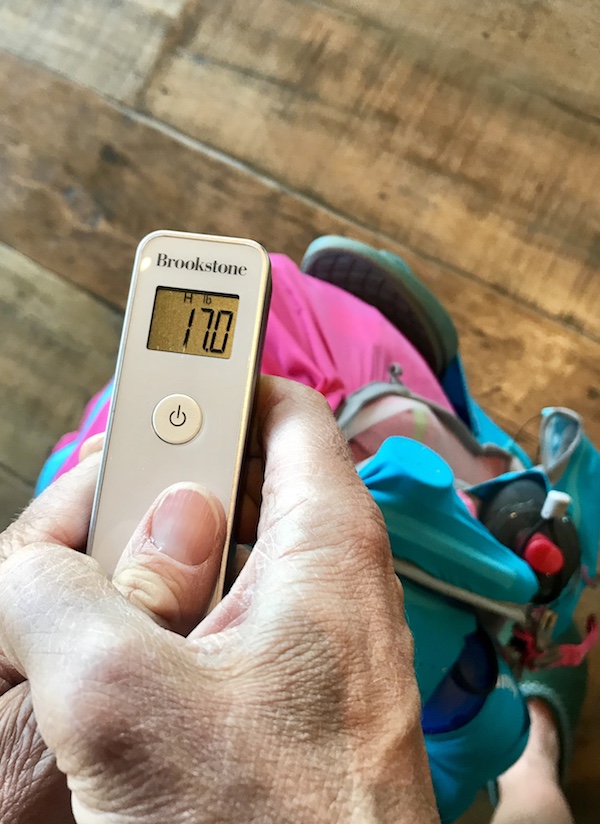
If You’re a Grand to Grand Ultra Competitor or Volunteer Reading This …
If you’ll be in Kanab on Thursday night, September 19, join me at Willow Canyon Outdoor store for a talk and book signing! I promise to share funny stories about past G2G’s, to read a brief passage from my book to help us sharpen our mental fortitude for the challenge ahead, and to do a Q&A about stage racing and ultrarunning. It should be a great chance for Grand to Grand participants, who are supposed to arrive in town by that day, to gather and meet one another.
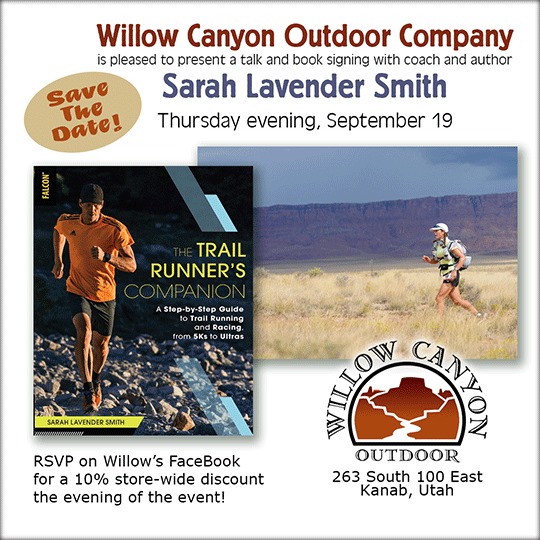
Also, you can find archived posts about training and gear for the Grand to Grand and its sister race, the Mauna to Mauna, in this category of my blog.
Finally, one last time, let me ask you to please check out my campaign page for the Conservation Lands Foundation. Please visit this page to read about how the public lands we’ll traverse and run near are threatened, and how the Durango-based Conservation Lands Foundation is advocating on their behalf and funding local environmental groups to do essential conservation work to safeguard them for future generations.

Sarah this is an awesome post! How much was the pack weight with everything? Thanks!
Thanks Doug! I honestly don’t know the final weight yet. I’m still making some choices with regard to food and extra clothing at camp. I’m going to get everything together this weekend, make sure it all fits, make some hard choices about what to eliminate, and then update the post with the final list & the weight.
Congratulations Sarah! When you have time, please update your pack list and weight. Can’t wait to hear about the race. Was the oatmeal, nut butter, coffee for breakfast; 2 x GU Rocktane drink mix, 1 GU gel, one GU Stroopwafel while running; GU Recovery mix for post-run snack; and one dehydrated meal enough sugar for running and calories in general?